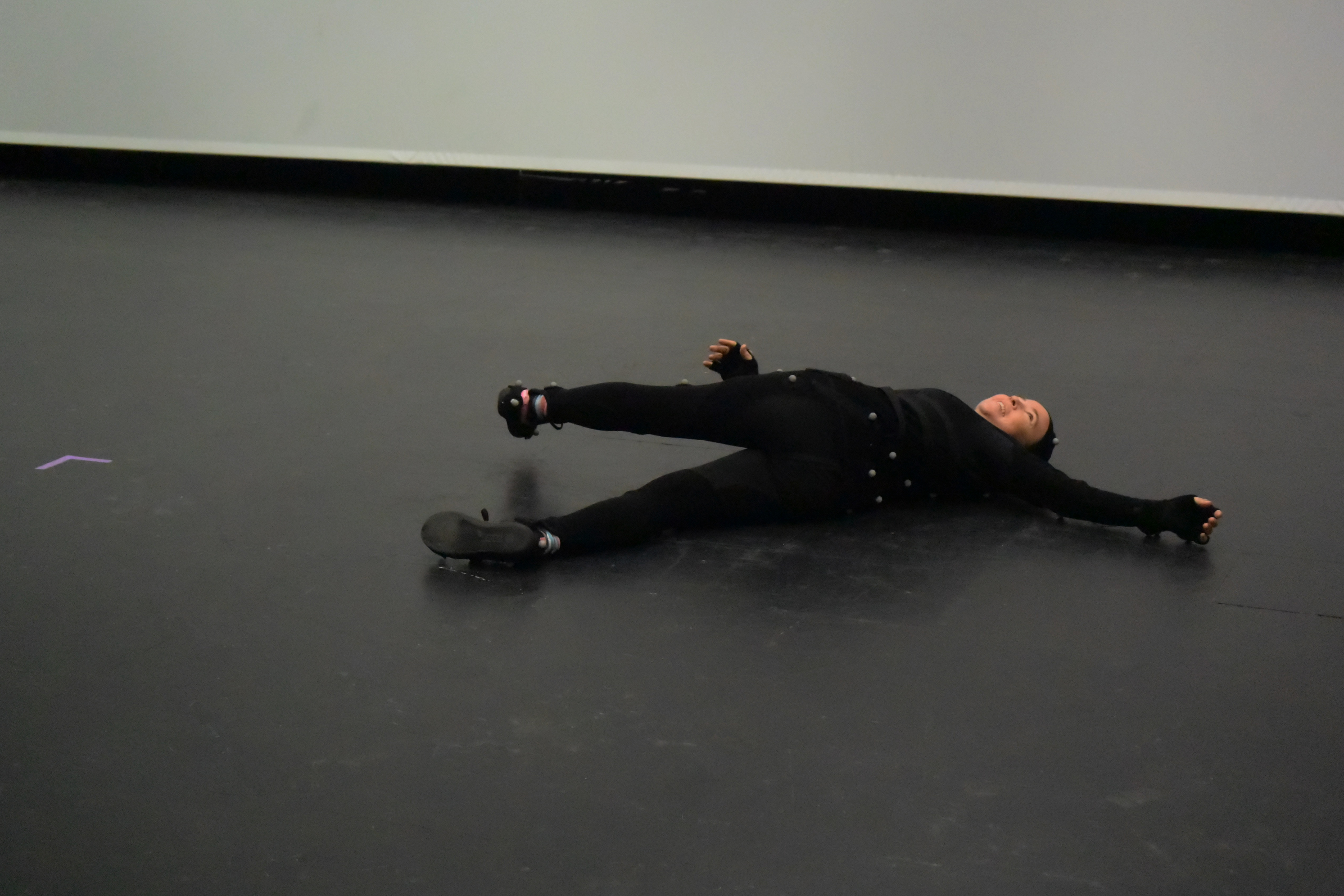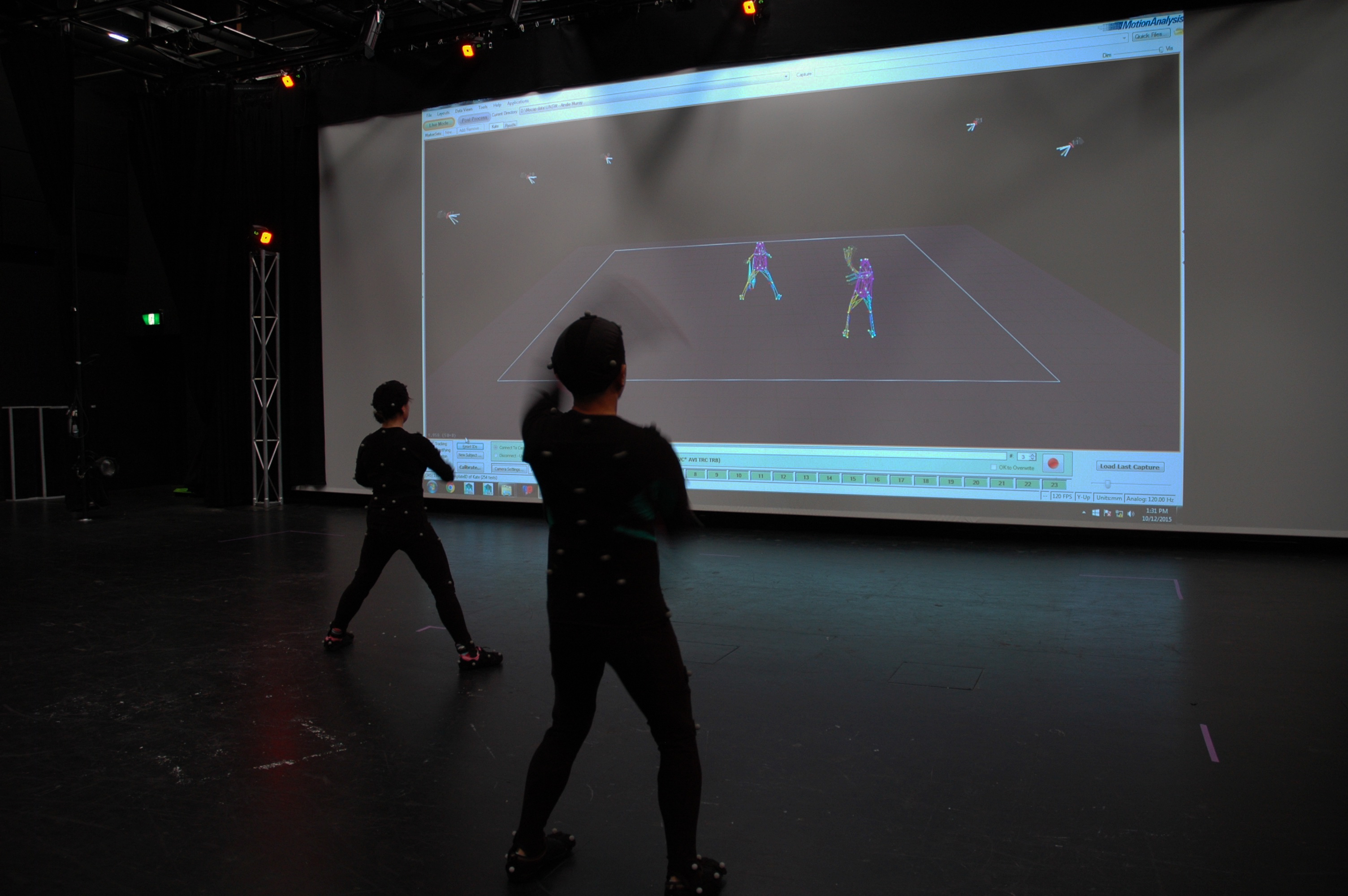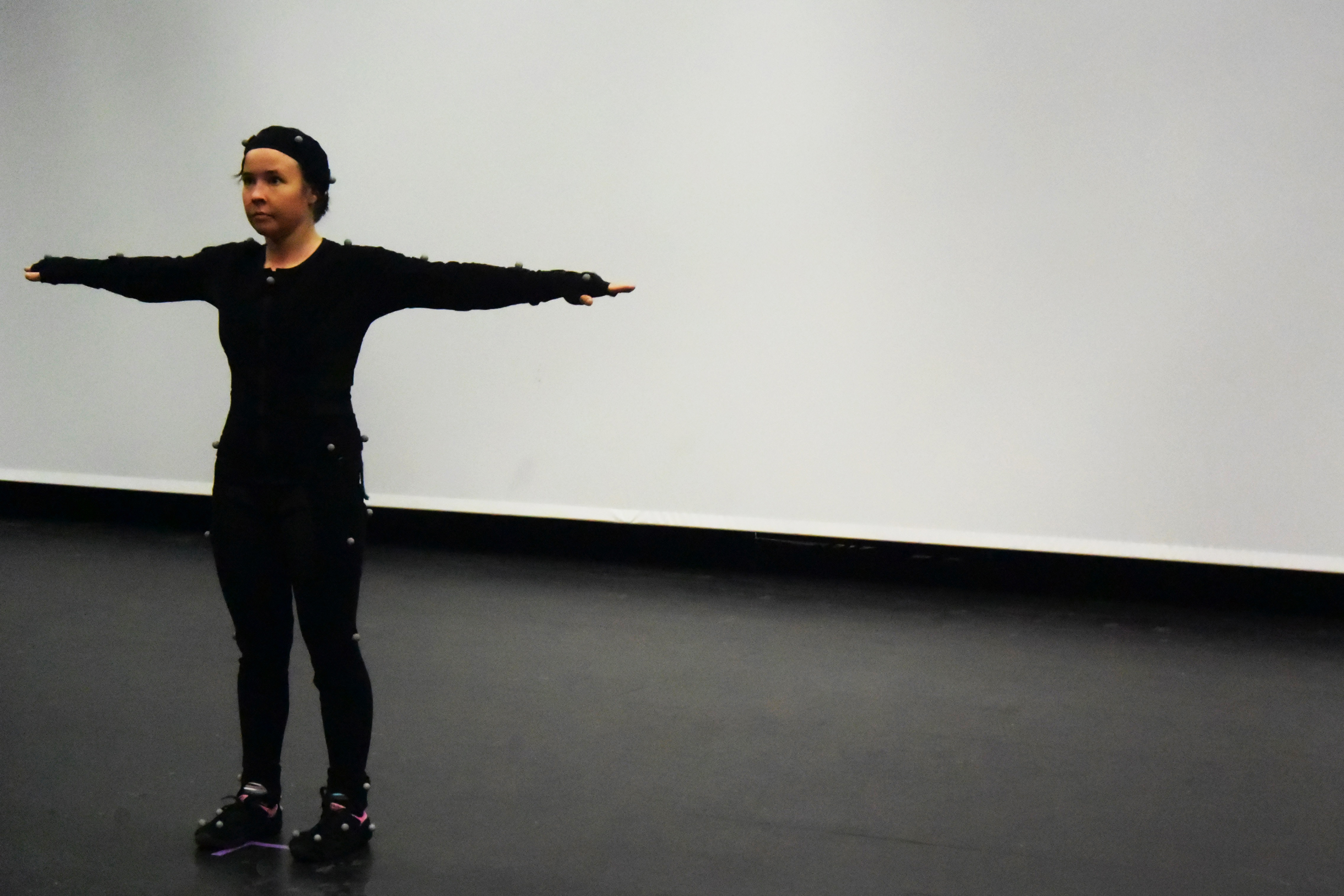Utterances of Everyday Life
Ainslie Murray
Everyday Life calls attention to the movements and resulting interactions that develop from the habitual patterns of daily life; those movements that, through their regularity, become invisible. In this practice-led work, airflows within and around a pair of dancers were visualised as they enacted a series of improvised everyday movements. Their magnified sense of their own spatial and bodily awareness was manifest as a kind of ‘kinaesthetic sympathy’ in which they were able to foreground aspects of their environment that are often elusive. The dancers heard the sounds of locomotion in the creaking, popping and grinding of their muscles flexing and extending. They felt the collision of body parts and ground. They smelled sweat and breath, and sensed proximity, tension, gravity and equilibrium as they moved.[01]

01. Everyday Life Setup Drawing B, 2016 (approx. 210 x 290mm, perforated Tyvek).

02. Everyday Life Setup Drawing A, 2016 (approx. 210 x 290mm, perforated Tyvek).
Invited to walk, spin and breathe, the improvised sequences of movements developed between the dancers encompassed a range of motion, from rapid, dynamic passages to slow and barely-discernible postural adjustments. As Erin Manning suggests, the ‘everyday’ is always a varied mix of improvised movement and a degree of individually-established habit, in which “we move not to populate environment, but to form it.”[02] The rapport between the dancers, which developed over years of relational improvisation, surfaced in subtle readings of the other’s intentions. The small differences, evident in the repetition of everyday movements and the spontaneous exchanges of improvised movement together, generated a range of gestural ‘drawings’ enacted as a kind of inhabitation in the field of moving air.



03. Motion Lab Performance with Kate Sherman and Ryuichi Fujimura.
The visualization of these drawings through film, coupled with the visualisation of the contextual airflows, form an architectural proposition in which space is agitated, stirred and concocted by the body, and where inhabitants actively generate an architecture through their movement. In the footage of these movements, the two bodies moving in relation to one another generate a spontaneous and responsive form of the ‘everyday’. Presented as twinned imagings, two types of footage contrast two alternative approaches to a visualization of sensitized air: a laboratory-based physical experiment on the right, and a digitally-generated speculation on the left. As the figures move within these two ‘screens’ we focus not on their movement or their absent bodies, but on the wake of their passage that is made visible through changes in the field of lines, and on the sheets of coloured light cutting across a field of smoke. Tides of smoke quietly advance across the frame; hypnotic whorls form and expand, the turbulent field collapses and diffuses. These imagings recall the compulsive experiments of the Bragaglia brothers and other Futurists who endeavoured to capture what they term the “persistence of movement.”[03] However, while the Futurist images are distinctly focussed on the moving body and often have a distinct physiological focus, the lens here shifts beyond their closed experiments to the air in which life takes place—the pervasive and invisible site of such persistence. They question what might happen when, for example, these experiments are extended beyond the lab, stage or studio? What might happen when these experiments are re-cast in the outside world?
Released from an artificial environment, the air makes itself known as a medium in which life takes place. We do not perceive the air as a substance external to us so much as we perceive in it;[04] we are within the air both internally and externally through breath, and there is no boundary between our bodies and the air as we breathe in space. This internality accounts in part for the sense of surprise that emerges in the observation of illuminated whorls of smoke forming and dissolving. There is an enduring wonder when we consider the air deeply; it is, like those invisible everyday movements, so present and so persistent as to be invisible. As Tim Ingold notes, we do not have a relationship with the air as one discrete entity might have with another, rather we are so intrinsically of the air that air must be understood as a medium that “ruffles every surface that it comes into haptic contact with,” instead of a mute substance that simply relates subject and object.[05]
What form does this ‘ruffling’ take, and how might we understand it as it affects the medium of air? The air is, according to Ingold, a supporting structure that suspends interaction and life and without which “birds would plummet from the sky, plants would wither and we humans would suffocate.”[06] Air, whether conceptualised as a fluid, swirling and dissolving mass or as an agent of infiltration and sustenance, becomes ‘sensitized’ through inhabitation.[07] In his observation of the movement of air in the outside world, Theodor Schwenk provides a vision of the air as a succession of surfaces that form and dissolve as air and object interact:
“When a breeze blows through a deciduous or a coniferous wood, it is parted by every leaf, every pine needle, closing again behind it while forming the most delicate vortex trains. A feature of the life of the wood is the fact that as well as the great surfaces formed by its leaves, corresponding ‘leaves’ are formed in the air by the wind, like trailers behind the real leaves… A similar thing happens when a bird or butterfly or other insect flies through the air; endless surfaces are ceaselessly being created in the air. Just imagine the surface formations made by insects as they hover and dart about on a summer’s day. At every moment an invisible ‘field of leaves’ made of air arises and dies away, engraved momentarily in the air by the tiny wings of the insects.”[08]
Manning proposes that we can think of movement in at least two ways:
1. I enter a room and see that room as pre-existing me. I walk across the room, drawing an imaginary line that cuts the space.
2. My movement creates the space I will come to understand as “the room.” The room is defined as my body + the environment, where the environment is an atmospheric body. Without that particular moving body that particular environment does not exist.[09]
This second way of thinking of movement returns us to the environment of the forest where the medium of air is already in a state of constant reorganisation as a result of the interactions of body and air. The air is sensitised - bristling with potential and behaving as a complex and interrelated three-dimensional field of influence. Turning his attention from forests to the sky, Schwenk describes the elastic qualities of air through birds flying in formation whereby separate birds are linked to one another through the surrounding air “as if by elastic threads” stretched taut in anticipation of adjustment.[10] Manning refers to this as the “elasticity of the almost,” a term to orientate our instinctive understanding of the possibility of movement in stillness, and the impact of action that has not yet occurred.[11] This imagining of the air as an elastic medium suggests an awareness of our being on the edge of a space made by the moving body; when the elastic contracts we feel the immediate perishing of one event and the concurrent pull into the next.[12]




04. Everyday Life, 2018. Video Stills.
The Everyday Life works are part of a series of drawings, models, still photographs and videos associated with experiments in movement and air. The drawings are used generatively to describe performances to collaborators, but also reflectively to document and analyse what actually took place but was not anticipated. In this way, the works operate dynamically within a research process as documents that both provoke and gather knowledge. The works are never finished as such, but are instead laid out as anchor points that prompt responsive cycles of approach and retreat. Both these movements—the approach towards the production of a work and the retreat from it after it is made—are active processes in the sense that the method employed is one of proceeding backwards, in what Manning describes as coming to “know negatively.”[13] Even here and now, writing seems akin to the erasure of a drawing or the ripping of a seam; the undoing of one structure motivated by the ambition of forming another. This raises multiple questions, all brought together in a non-linear relationship of varied parts. The work was made and is now deciphered by the maker; the smoke has emanated and dispersed and is now a mere echoic photographic trace; the dance was enacted and has now passed through its own inevitable process of self-erasure.[14]
The drawings of Everyday Life operate ‘backwards’ and the method developed for handling the multiple invisibilities at play involves producing drawings as ‘negatives’. The traditional additive processes of drawing are reversed using drawing instruments that dissolve the drawing surface, and the resulting drawings are intricate networks of interrelated negative spaces. In this way, the drawings are presented as planes eroded through considered gestural action, where intensity is reflected through absence rather than matter. The more they are drawn, the more they threaten to disappear entirely. Like the systems of choreographic notation employed by Trisha Brown and William Forsythe that utilise vectors and gesture respectively, the drawings address that which is reforming in the precise moment that it is articulated.[15] The drawings are ‘utterances’, likened to the word as it is spoken and caught in the surprising ambiguity of actualisation.[16] Once spoken, the retreat from the alluring but ultimately misleading state of certainty is both necessary and inevitable because “artistic experience actually needs this aspect of indescribability in order to be able to justify itself and define itself as the counterpart to speech, the extra sense, the surplus of meaning.”[17] In resisting a polarised framework of question and answer, this work instead aims to open the possibility of a grafted practice that might prick the architectural conscience and, perhaps, expand it. We do not see the whorls of air or the tides of forming and collapsing surfaces, but once grasped—however fleetingly—architectural space suddenly seems very different.
Notes
[01] See Foster, Susan Leigh. 1997. ‘Dancing Bodies’ in J. Desmond (ed.), Meaning in Motion: New Cultural Studies of Dance. Durham and London: Duke University Press, p.237. Foster discusses the notion of kinaesthetic sympathy in relation to dancing bodies.
[02] Manning, Erin. 2012. Relationscapes: Movement, Art, Philosophy. Cambridge, MA: MIT Press, p.13.
[03] Souriau, Paul. 1983. The Aesthetics of Movement. Translated by Manon Souriau (ed.). Amherst, MA: University of Massachusetts Press, p.181.
[04] Ingold, Tim. 2015. The Life of Lines. Abingdon, Oxon: Routledge, p.70.
[05] Ingold, Tim. 2015. The Life of Lines, p.150.
[06] Ingold, Tim. 2015. The Life of Lines, p.70.
[07] See Schwenk, Theodor. 2014. Sensitive Chaos: The Creation of Flowing Forms in Water and Air. East Sussex: Rudolf Steiner Press.
[08] Schwenk, Theodor. 2014. Sensitive Chaos, p.119.
[09] Manning, Erin, 2012. Relationscapes, p.14.
[10] Schwenk, Theodor. 2014. Sensitive Chaos, p.116.
[11] Manning, Erin. 2012. Relationscapes, p.32. Manning discusses ‘elasticity’ at length in ‘The Elasticity of the Almost’, pp.29-42.
[12] Manning, Erin. 2012. Relationscapes, p.39.
[13] Manning, Erin. 2012. Relationscapes, p.59.
[14] Lepecki, André. 2004. ‘Introduction: Presence and Body in Dance and Performance Theory’ in Lepecki, André (ed.). On the Presence of the Body: Essays on Dance and Performance Theory. Middletown, CT: Wesleyan University Press, p.5.
[15] See Louppe, Laurence (ed.). 1994. Traces of Dance: Drawings and Notations of Choreographers. Translated by B. Holmes and P. Carrier. Paris: Editions Dis Voir.
[16] de Certeau, Michel. 1988. The Practice of Everyday Life. Translated by S. Randall. Berkeley: University of California Press, p.117.
[17] Cramer, Franz Anton. 2007. ‘Knowledge, Archive, Dance’ in deLahunta, Scott (ed.). Capturing Intention: Documentation, Analysis and Notation Research Based on the Work of Emio Greco/PC. Amsterdam: Emio Greco/PC and Amsterdamse Hogeshool vor de Kunsten Lectoraat, p.12.
Figures
Banner.
Screening “I’ll Give You Data” (right screen) and Installation. Photograph: Alex Wisser.
01.
Everyday Life Setup Drawing B, 2016 (approx. 210 x 290mm, perforated Tyvek).
02.
Everyday Life Setup Drawing A, 2016 (approx. 210 x 290mm, perforated Tyvek).
03.
Motion Lab Performance with Kate Sherman and Ryuichi Fujimura. Photograph: Ainslie Murray.
04.
Everyday Life, 2018. Video Stills.
Video
Murray, Ainslie. 2018. Everyday Life. 2-channel video, sound. Courtesy of the artist.
Performers: Kate Sherman and Ryuichi Fujimura
Audio: ‘Deep Space Breathing’ by MAN ON WAX/ESOTERIC
Videographer and Editor: Kuba Dorabialski.
Special thanks to Tracie Barber, Kyle Forster, Billi Hayes and Jordan Vincent. Filmed in the Fluid Dynamics Laboratory, UNSW School of Mechanical and Manufacturing Engineering, and at Deakin Motion.Lab. The artist gratefully acknowledges the support of Deakin Motion.Lab and the UNSW Faculty of the Built Environment in the development of this work
https://doi.org/10.2218/nznf8p58
